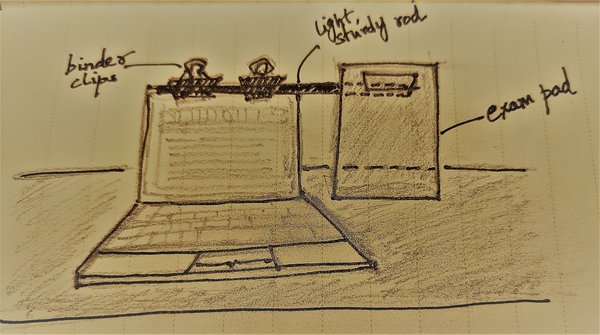
"When we describe the purpose of an object - what it is designed to do - then we are making a normative claim," my advisor the late Prof. Gautam said while hurrying to get somewhere. It was a simple but insightful remark. At the time, I was struggling with the concept of normative objects. Normativity has to do with the function of an object. When we say that the function of a blackboard is to provide a surface to write on, we are making a normative claim on the blackboard. This is the source of our evaluative concepts of good and bad. A good blackboard is one which realizes its function more effectively than another. Makes sense!
I understood this one day in the library. I'd made a simple contraption to hold a book up next to my laptop, to work between the screen and the page easily. Take a lightweight but sturdy rod that is one and a half times longer than the width of your laptop screen; clamp it on top of the laptop screen with binder clips so that it protrudes out of the screen; the screen must be rigidly hinged to the bottom and not sway. Now attach an exam pad to hold the book against the protruding length of the rod. There you go! You've made a sidecar to hold the book upright (I later learnt that this is known as a 'copy-aid'). People smiled in amusement at my contraption. I’d smile back with a shrug. It served me well.
One day, a guy came up to me, asking about the 'sidecar'. He found that it could be a helpful tool and wanted to know where to get one and how much it cost. I described my DIY hack to him excitedly so that he could easily put one together himself. But he seemed pretty disappointed to learn that it was a hack and not something he could buy. That’s interesting, I thought. Why did he feel let down? Then it struck me. May be what he wanted was a normative artefact! He wanted something designed for the purpose. A hack was not normative. It would work as long as it could, but it was not obliged to do so. A designed artefact, on the other hand, comes with the norm of function. If it did not, it was malfunctioning. You can blame it on the designer. A hack comes with no guarantee, does it?
After that serendipitous moment, I saw things in a new light. Everywhere I looked, I saw things designed for one thing or another. The built world appeared to me as a normative world. All our claims of good, bad, right, wrong, moral, ethical appeared to be grounded in this. And this is what engineers and designers do—they don’t just design and produce objects, they produce norms which play a significant part in our everyday engagements. And these norms are either appropriated and become part of the culture of a group or society at large, or they become a point of contestation. And these norms are in a state of constant flux, some get turned into rules like wearing a helmet when riding, while most others operate in the gray zone between expectations and obligations (like calling someone whose call you missed).
I am an engineer studying philosophy. Engineers analyze and refine norms of functional objects. So, they work with value-laden norms too. Philosophers do the same with concepts like as 'knowledge', 'freedom', 'meaning' etc. Could this be the meeting point for philosophers and engineers? While writing my thesis, my serendipitous library encounter collapsed the distinction between the abstract and the concrete. And helped draw a bridge between two otherwise separate disciplines.
Ashwin Jayanti teaches philosophy at IIIT-Hyderabad.
23 June 2021